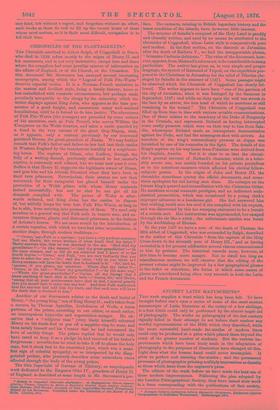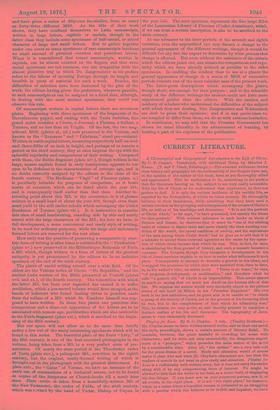• ANCIENT LATIN MANUSCRIPTS.* Tins work supplies a want which
has long been felt. To have brought before one's eyes a series of some of the most ancient manuscripts of Latin literature at the outlay of a few shillings, is a feat which could only be performed by the almost magic aid of photography. The works on palmography of the last century signally failed in their attempt to set before their readers any worthy representations of the MSS. which they described, while the more successful hand-made fac-similes of modern times could only be produced at a price which placed them beyond the reach of the greater number of students. But the various im- provements which have been lately made in the adaptation of photography to the purposes of illustration have changed all this. Light does what the human hand could never accomplish. It gives us perfect and unerring fac-similes; and the permanent processes of photographic printing multiply impressions as durable as those which issue from the engraver's press.
The editors of the work before us have made the best use of these modern improvements. Following the plan adopted by the London Paheographical Society, they have issued their work in a form corresponding with the publications of that society,
• Exempla Codkum Latinorum Lilies-is (liglissculis Scriptorum. Ediderunt Carole!' Zangemelater et eallehnus Wattenbach. Heidelberg.), 1876. and have given a series of fifty-one Lac-similes, from as many as forty-three different MSS. As the title of their work shows, they have confined themselves to Latin manuscripts, written in large letters, capitals or uncials, though in the latter class they include some specimens of half-uncial, or mixed character of large and small letters. But to gather together under one cover so many specimens of rare manuscripts betokens no small amount of personal exertion and persistent labour. When it is remembered that extant manuscripts, written in capitals, can be almost counted on the fingers, and that even uncial specimens are not common, one can sympathise with the almost plaintive way in which Dr. Zangemeister in his preface refers to the labour of scouring Europe through its length and breadth in quest of material for such a work. Besides, the tlifficulties of selection have been increased by the plan of the work, the editors having given the preference, wherever possible, to such manuscripts as can be assigned to a fixed date, although, in dealing with the most ancient specimens, they could not observe this rule.
Of manuscripts written in capital letters there are seventeen
• 'plates. Beginning with three specimens of the fragments of the Herculaneum papyri, and ending with the Turin Sedulius, this grand series contains a Cicero, a Juvenal, a Plautus, a Ballast, a Terence, and no less than six Virgil"). Of the last, the two mag- nificent MSS. (plates xi., xii.) now preserved in the Vatican, and known as the " Romanus " and " Palatinus," stand pre-eminent. Written in rustic capital letters, measuring respectively half-an-inch and three-fifths of an inch in height, and perhaps of so remote a period as the third century, they at once impress the eye with the splendid regularity and compactness of their writing. Compared with them, the Berlin fragment (plate xiv.), though written in the large, square capitals found in early inscriptions, appears to our eyes to be deficient in the characteristics of extreme age, and is no doubt correctly assigned by the editors to tile close of the fourth century. The Medicean " Virgil " of Florence (plate x.) is peculiarly yaluable for purposes of comparison, as it bears marks of recension which can be dated about the year 494, and is consequently itself earlier than that time. Another in- teresting point about this MS. is the occurrence in it of glosses written in a small hand of about the year 600, though even these must yield to the still earlier scholia which accompany the Codex Bembinus of Terence (plate viii.). It is instructive to examine this class of small handwriting, standing side by side and nearly coeval with the large characters of the MS., for here we have, in full development, a more convenient and ready style of writing, to be used for ordinary purposes, while the large and elaborately formed letters are reserved for the text alone.
How early was the practice of preserving a comparatively obso- lete form of writing in after times is exhibited in the " Prudentius " (plate xv.) now preserved in the Bibliotheque Nationale of Paris, a MS. which, though written in a form of letters of the greatest antiquity, is yet pronounced by the editors to be an imitative specimen of the, end of the sixth century. The plates of uncial writing extend over a wide field. Of the oldest are the Vatican codex of Cicero "Dc Republica," and the ancient Latin version of the Bible preserved at Vercelli (plates xvii. and 'ix.), of the fourth century. The veneration with which the latter MS, has been ever regarded has caused it to suffer mutilation, which a less sacred volume would have escaped, at the Lands - of believers who found healing virtue in powders made from the vellum of a MS. which St. Eusebius himself was sup- posed to have written. In these two plates one perceives that compactness and a clean-cut appearance of the letters are to be associated with remote age, peculiarities which are also noticeable in the Fulda fragment (plate xxi.), which is ascribed to the begin- ning of the fifth century.
But our space will not allow us to do more than briefly notice a few out of the many interesting specimens which will be found in this series. The beautiful plate of the Paris " Livy," of the fifth century, is one of the best-executed photographs in the Tolume, being taken from a MS. in a very perfect state of pre- servation. Of nearly the same period is the Theodosian codex of Turin (plate xxv.), a palimpsest MS., rewritten in the eighth century, but the original, neatly-formed writing of which is brought out in the photograph with the greatest distinctness. In plate xxiv., the " Gaius " of Verona, we have an instance of the early use of contractions of a technical nature, not to be found in copies of the Scriptures or Church-books till a much later time. Plate xxxiv. is taken from a beautifully-written MS. of the New Testament, the codex of Fulda, of the sixth century, which was r-vised by the hand of Victor, Bishop of Capaa, ia
the year 546. The next specimen represents the flue large Bible of the Laurentian Library of Florence (Codex Amiatinus), which, if we can trust a certain inscription, is also to be ascribed to the sixth century.
As one advances to the later periods of the seventh and eighth centuries, even the unpractised eye may discern a change in the general appearance of the different writings, though it would be difficult for any but the expert to determine by what process that change is effected. But even without the assistance of the criteria which the editors point out, one misses the compactness and regu- larity which we have already noticed as peculiar to the older specimens. In enabling the student thus to see at a glance the general appearance of change in a series of MSS. of successive periods consists one of the most valuable uses of the present work.
The letter-press descriptions which accompany the plates, though short, are enough for their purpose ; and in the scientific study of the different writings the student could not have more experienced guides than the editors. With the caution and modesty of scholars who understand the difficulties of the subject with which they are dealing, Drs. Zangemeister and Wattenbach are slow to press their opinions ; and if in any particulars we are tempted to differ from them, we do so with extreme hesitation.
In conclusion, we may add that the Prussian Government has shown its usual liberality in the advancement of learning, by bearing a part of the expenses of the publication.































 Previous page
Previous page